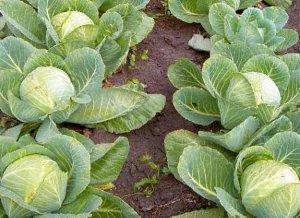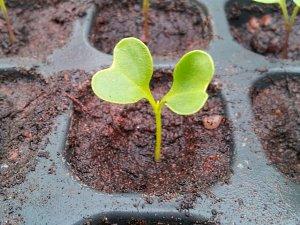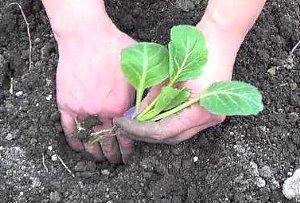White cabbage - growing and care
 Changes in the climate are making it difficult to grow vegetables. How to care for white cabbage in the conditions of non-standard natural phenomena and get a good harvest?
Changes in the climate are making it difficult to grow vegetables. How to care for white cabbage in the conditions of non-standard natural phenomena and get a good harvest?
White cabbage is a cold-resistant, light-loving plant. For its full development and maturation, a daylight hours of at least 13 hours are required. Depending on the region, early and mid-season varieties ripen no earlier than 70 days or more. How to properly grow white cabbage to get a good harvest in any region? To do this, you must adhere to some rules.
How to choose and prepare white cabbage seeds?
The growing region plays a major role in the selection of seeds for sowing. The further north the site is, the more early ripening varieties you need to choose. On the packaging, the description contains the sowing time and the estimated harvest of the crop.
But, as a rule, these data are indicated in the case of strict adherence to the agricultural technology of care and cultivation. Such violations, as well as failure in climatic conditions - drought, heavy and prolonged rains, prolonged frosts - negatively affect the agricultural technology of growing white cabbage.
The main task of preparing the seeds of white cabbage is to improve their germination and further healthy development of sprouts. For this, a number of events are carried out with seeds:
- Calibration;
- Hardening;
- Stratification - keeping wet seeds for a certain amount of time at low temperatures;
- Soaking in a disinfectant solution;
- Warming up;
- Processing with microelements;
- Germination.
The process can be described as follows. After calibration, dry white cabbage seeds are placed in hot for 15 minutes (about 45-50 C0) water. Then it is immersed in cold liquid for a minute. A solution with trace elements is brought in and put into it for 12 hours. Then washed with clean water and placed in a refrigerator for a day. It remains to dry the seeds and sow.
Soil preparation for sowing and seedlings
On seedlings seeds are sown in boxes. But to make the plants easier to transfer the transplant into open ground, it is better to sow each seed in a separate container.

When planning a place for planting white cabbage seedlings, it is worth remembering which culture was its predecessor. It is advisable that onions, green manures, cereals, carrots, cucumbers and potatoes grow here before.
It is necessary to exclude the planting of a vegetable crop in the place of the cruciferous family - radishes, radishes, various types and varieties of cabbage, beets, turnips, as well as tomatoes.
The plot for cabbage is prepared in advance, preferably in the fall. If the soil is acidic, then lime substances are added. Neutral soils are most favorable.
In the spring, organic and mineral fertilizers are added per 1 m2:
- Wood ash - 3-4 glasses;
- Overripe organic matter - 1 bucket;
- Urea - 1 tablespoon;
- Superphosphate - 2 tablespoons.
The soil is dug up, weeds are removed from the roots and the beds are prepared by applying fertilizers.There can be several options for the formation of beds, it all depends on the preferences and physical strength of the gardener. Planting in boxes, a separate bed for each seedling, rectangular beds in 1 and 2 rows, etc. It is important that when watering the water did not flow to one bush, but was evenly distributed over the entire surface, irrigating all the plants.
If dry winds prevail in the region or there are problems with water, timely loosening and mulching will help to prolong soil moisture.
How to properly plant white cabbage seedlings
 In the prepared beds, holes are made with a hoe. It is important that their depth is slightly greater than the height of the plant's root system. If the hole is larger than necessary, then a little earth is added to it. The main thing is that the depth is not less than the root. Otherwise, the plant will fall and root poorly.
In the prepared beds, holes are made with a hoe. It is important that their depth is slightly greater than the height of the plant's root system. If the hole is larger than necessary, then a little earth is added to it. The main thing is that the depth is not less than the root. Otherwise, the plant will fall and root poorly.
Another important point. When planting a plant, you need to ensure that the rosette of the cabbage is not covered with earth. Otherwise, its growth will stop and the culture will die.
 Before planting white cabbage, water it. If the seedling sits in a separate pot, then after the soil has become saturated with moisture, it is carefully turned upside down with one hand, grasping the upper surface of the container with the palm of the other hand. In this case, a stem should remain between the fingers. By gently shaking the pot, a lump of earth along with the root will come out and remain intact in the palm of your hand. It remains only to turn it upside down, put it in the hole, sprinkle it tightly with earth and water it.
Before planting white cabbage, water it. If the seedling sits in a separate pot, then after the soil has become saturated with moisture, it is carefully turned upside down with one hand, grasping the upper surface of the container with the palm of the other hand. In this case, a stem should remain between the fingers. By gently shaking the pot, a lump of earth along with the root will come out and remain intact in the palm of your hand. It remains only to turn it upside down, put it in the hole, sprinkle it tightly with earth and water it.
Planting scheme for early varieties - 40X25 cm, medium and late - 40X60 cm.
If, after planting the seedlings, a strong heat is expected, then caring for white cabbage, in addition to mulching the soil, will consist in protecting young leaves from sunburn. To do this, you can make a small canopy, the basis of which is a wooden or metal frame, covered with non-woven material or any light-colored cloth.
Necessary conditions for growing white cabbage
To get a good harvest, it is important to maintain the basic conditions for growing white cabbage:
- Optimum air and soil temperature during the growing season and ripening; otherwise, it will lead the plant to bloom and other problems;
- Adequate amount of light; do not plant plants near trees or in other shaded areas; the cabbage will stretch out; this will cause poorly tying a fork or head of cabbage;
- Watering; cabbage is very demanding for timely abundant watering; but it is worth remembering that excessive everyday moisture will lead to premature cracking of the fork;
- Tillage - loosening, mulching will reduce the number of irrigations and provide free air access to the root system;
- Mineral fertilizing and organic;
- Protection from pests and diseases.
When growing white cabbage, you need to take into account the cold-resistant qualities of the plant. For example, frost resistance depends on the age and variety of the crop. For sprouts to appear, 2-3 degrees above zero are enough. But friendly shoots will appear in 4-5 days at a temperature of about 20 degrees Celsius.
Hardened seedlings with a developed root system or planted in the ground no earlier than 10-14 days can cope with the effects of night frost. In this case, the thermometer should be at least 3-5 degrees below zero. The optimum air temperature for growing seedlings is 13-15 C0, and soils - 2-3 degrees lower.
If it is difficult or impossible to maintain the necessary conditions outdoors for the development and cultivation of white cabbage, then it is worth taking care of the construction greenhouses... It is important to choose varieties bred for indoor cultivation. This will avoid many diseases, especially fungal, characteristic of the cruciferous family.
Here you can see varieties of white cabbage with a photo.

What is the peculiarity of growing cabbage in a seedless way?
 White cabbage, grown in a seedless way, gives a high yield 10-12 days ahead of schedule. Seeds are sown in 3-4 pieces in one nest and immediately to a permanent place. What is the peculiarity of this method?
White cabbage, grown in a seedless way, gives a high yield 10-12 days ahead of schedule. Seeds are sown in 3-4 pieces in one nest and immediately to a permanent place. What is the peculiarity of this method?
It is necessary to be very careful when choosing a site, because completely unprotected crop sprouts will appear there. Protection from pests and diseases is somewhat more difficult than in greenhouse conditions. Before planting, the soil should be cleared of the roots of weeds and harmful insects as much as possible. White cabbage grown in this way is more hardy, seasoned and productive.
Seeds are pretreated and sown in well-prepared soft moist soil, sprinkling peat... After germination, the plants are thinned out, leaving the strongest.
It is very important to get a stocky bush with a thick leg when growing seedlings, and this is achieved only with rare planting and growing with a little insulation in a greenhouse. You cannot grow high-quality cabbage seedlings at home.
The scourge of cabbage is leaf-gnawing and root-gnawing pests. To get away from the cabbage fly, you need to plant the cabbage before the threat of frost has passed. The root develops better, and the fly has not yet risen on its wing. Water the wells with fragrant infusions to kill the smell of cabbage. And against caterpillars during the flight of butterflies, you need to inspect the lower plate of leaves every ten days. The clutches are clearly visible, develop for 2 weeks, with regular examination, no chemistry is required.
Some cultivars have a hard cover leaf and butterflies do not lay eggs on it. An example is Julia, Megaton is probably a lot of such varieties. Regular watering, ash dusting and organic fertilizing during the season will allow you to get a good harvest without chemicals.